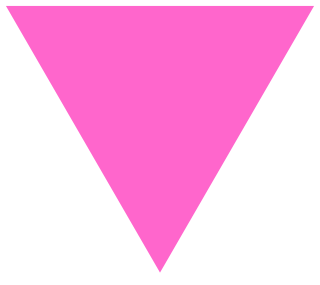 W
WThe black triangle was a badge used in Nazi concentration camps to mark prisoners regarded asozial ("anti-social") and arbeitsscheu ("work-shy"). Those considered anti-social included primarily the Romani but it was also used until 1942 to describe alcoholics, homeless, beggars, nomads, and prostitutes. Women deemed to be anti-social included sex-workers, nonconformists, and lesbians. The term "asocial" was originally applied to heterosexual women who engaged in sex outside of marriage, which included prostitutes.
 W
WDIY rainbow crossing was a protest movement that emerged in Sydney in 2013. The campaign involved members of the community creating rainbow pedestrian crossings in chalk to protest the removal of a temporary rainbow crossing from Oxford Street in Sydney. The temporary crossing was created by the City of Sydney as part of the 35th-anniversary celebration of the Sydney Mardi Gras. When the crossing was to be removed, the community protests and internet activism campaign emerged. In 2019 a permanent Sydney rainbow crossing was unveiled in Taylor Square, on the corner of Bourke and Campbell streets.
 W
WThe handkerchief code is a system of color-coded cloth handkerchief or bandanas for non-verbally communicating one's interests in sexual activities and fetishes. The color of the handkerchief identifies a particular activity, and the pocket it is worn in identifies the wearer's preferred role in that activity. Wearing a handkerchief on the left side of the body typically indicates one is a "top", while wearing it on the right side of the body would indicate one is a "bottom". For example, a dark blue handkerchief indicates an interest in anal sex, and wearing it in the left pocket indicates a preference for being the insertive partner. The code was most widely used in the 1970s in the United States, Canada, Australia, and Europe, by gay and bisexual men seeking casual sex, or BDSM practitioners.
 W
WLabrys is, according to Plutarch, the Lydian word for the double-bitted axe.. The Ancient Greek plural of labrys is labryes.
 W
WA pink triangle has been a symbol for various LGBTQ identities, initially intended as a badge of shame, but later reclaimed as a positive symbol of self-identity. In Nazi Germany in the 1930s and 1940s, it began as one of the Nazi concentration camp badges, distinguishing those imprisoned because they had been identified by authorities as gay men, a category that also included bisexual men and transgender women. In the 1970s, it was revived as a symbol of protest against homophobia, and has since been adopted by the larger LGBTQ community as a popular symbol of LGBTQ pride and the LGBTQ rights movement.
 W
WThe term safe space refers to places created for individuals who feel marginalized to come together to communicate regarding their experiences with marginalization, most commonly located on university campuses in the western world, but also at workplaces, as in the case of Nokia.
 W
WThe White Knot is a symbol of support for same-sex marriage in the United States.